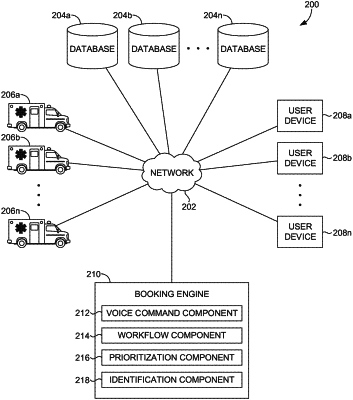| CPC G16H 10/20 (2018.01) [G06F 3/167 (2013.01); G06Q 50/30 (2013.01); G16H 10/60 (2018.01)] | 14 Claims |

|
1. One or more computer storage media having computer-executable instructions embodied thereon that, when executed by a computer, causes the computer to perform operations for providing voice-activated ambulance booking, the operations comprising:
receiving, at a user device in a locked state, a request from a user, the request initiating a workflow that enables the user to provide information about a patient to a booking engine;
providing the workflow to the user, via a user interface of the user device while the user device is in the locked state, the workflow comprising a series of questions corresponding to a status of the patient;
transmitting, from the user device to an ambulance booking system, via a network while the user device is the locked state, a request for an ambulance for the patient, the ambulance requested based on responses from the user, via the user interface of the user device, to the series of questions, and a detected location of the user device;
determining, by the ambulance booking system, that a plurality of requests have been received from other patients and a single ambulance is available;
obtaining, by the ambulance booking system, battery statuses of devices making the plurality of requests and/or signal strengths of devices making the plurality of requests;
prioritizing, by the ambulance booking system, the plurality of requests based on the battery statuses of the devices making the plurality of requests and/or the signal strengths of the devices making the plurality of requests;
assigning, by the ambulance booking system, the single ambulance to the patient or a patient of the other patients based on the prioritizing; and
tracking the single ambulance in real-time, via the user interface, until it reaches the detected location of the user device.
|